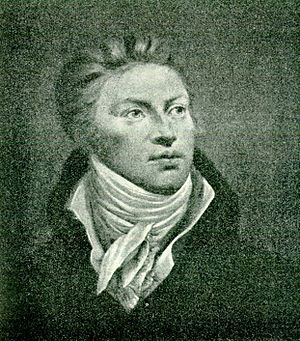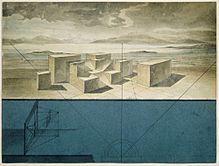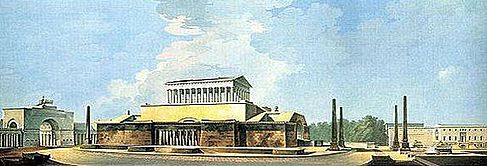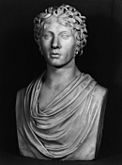Friedrich Gilly facts for kids
Quick facts for kids
Friedrich Gilly
|
|
|---|---|

Friedrich Gilly
|
|
| Born |
Friedrich David Gilly
16 February 1772 Altdamm, Pomerania
|
| Died | 3 August 1800 (aged 28) |
| Nationality | German |
| Occupation | architect |
Friedrich David Gilly (born February 16, 1772 – died August 3, 1800) was a German architect. He was the son of another famous architect, David Gilly. Friedrich Gilly's buildings were inspired by a style called Revolutionsarchitektur, which means "revolutionary architecture." This style was popular during a time of big changes in Europe.
Friedrich Gilly was born in Altdamm, Pomerania. This place is now called Dąbie and is part of Szczecin, Poland. He was known as a very talented young person, almost a "prodigy." He also taught the famous architect Karl Friedrich Schinkel when Schinkel was young.
Contents
Becoming an Architect
Friedrich Gilly started studying architecture in 1788. He went to the Akademie der Künste (Academy of Arts) in Berlin. His main teachers for architecture were Friedrich Becherer and Carl Gotthard Langhans.
Gilly also took drawing lessons from many artists. These included Christian Bernhard Rode, Johann Christoph Frisch, Johann Heinrich Meil, Daniel Nikolaus Chodowiecki, and Johann Gottfried Schadow. For hands-on building experience, he learned from Carl Gotthard Langhans, Michael Philipp Boumann, and Baron Friedrich Wilhelm von Erdmannsdorff.
Early Work and Travels
In 1789, Gilly began working for the Oberhofbauamt, which was a royal building office. He helped rebuild the town of Neuruppin for a while, working with Bernhard Matthias Brasch.
In 1797, Gilly traveled a lot. He visited France, England, and Austria. The drawings he made in France show his interest in architecture. They also show the popular ideas of the time, known as the Directoire period. His drawings included places like the Fountain of Regeneration and the Rue des Colonnes in Paris. He also drew the chamber of the Council of Ancients in the Tuileries Palace and Jean-Jacques Rousseau’s grotto in Ermenonville.
Designing a Monument
In 1797, Gilly designed a monument for Frederick II of Prussia. This design showed how much he was influenced by French neoclassicism. This style was popular at the time and was also used by architects like Etienne-Louis Boullée. Gilly wrote notes explaining that he wanted the building to make people feel inspired. His design for the monument is now kept at the Kupferstichkabinett Berlin in Berlin.
Teaching and Later Life
From 1799, the young architect Karl Friedrich Schinkel lived with the Gilly family in Berlin. Friedrich Gilly and his father, David Gilly, taught Schinkel.
Friedrich Gilly became a professor at the Berlin Bauakademie (Building Academy) when he was only 26 years old. Sadly, not many of his buildings are still standing today. One of his designs that did survive for a while was a mausoleum (a building for burials). It was built between 1800 and 1802 in Dyhernfurth, near Breslau (now Brzeg Dolny near Wrocław, Poland). It looked like an ancient Greek temple. However, it was destroyed after 1945.
Friedrich Gilly died from tuberculosis when he was only 28 years old. He passed away in Karlsbad, where he was buried in the cemetery of Andreaskapelle.
Images for kids
- Friedrich Gilly's works
-
Friedrich Gilly. Bust by Gottfried Schadow
Bust by Schadow
- Bust of Friedrich Gilly (by Johann Gottfried Schadow, 1801)
See also
 In Spanish: Friedrich Gilly para niños
In Spanish: Friedrich Gilly para niños




